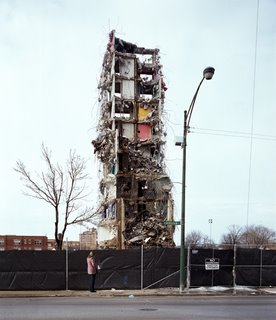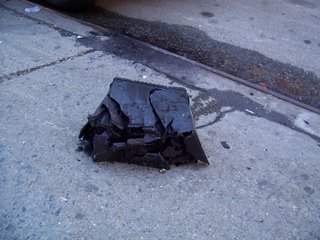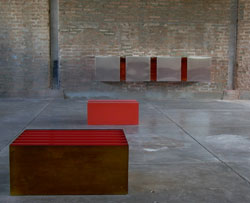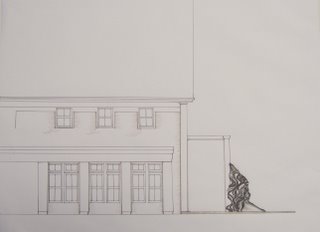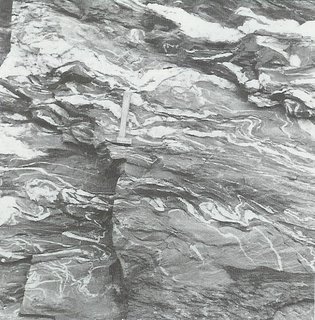I want to start by saying that I probably shouldn't even go to a Donald Kuspit lecture, because I have a deep personal distrust of psychology and I am irritated by all that gassy talk about artists being narcissistic and obsessed with overcoming mortality. It makes me feel so defensive... so let me get this out of the way:
Sure. The monumental, permanent nature of sculpture did attract me as an insecure, obnoxious twenty year old with a huge chip on her shoulder. But my mature work is an exploration of a sculpture's (and my own) mortality.
And yeah. My ego is enormous. But again, I can't keep playing this game unless I keep that ego-drive in check. Actually doing the work of being an artist requires much more humility than one might think, and humility is much more interesting than ego.
I don't know why I make art, exactly, and I might have gotten into it because I am self-aggrandizing and fear death. But as I continue to make art, I can say with certainty that anyone who continues to make art for these reasons is in for nothing but disappointment. Art is, unfortunately, just not that important.
So, while it did stir my passions, I did not sympathize intellectually with Kuspit's basic thesis. He posited last night that artists are driven to be singular in their vision and use that Singularity Of Vision to catapult over mortality, and that they therefore must hate the critic, because the critic destroys the Singular Vision Of The Artist. The critic separates works of art from the artist's individual ego, and plugs them into a larger social and art historical context. Half of this argument is essentially modernist (again, not surprising, this was a Donald Kuspit lecture) and entirely dependent upon Avant-Gardeism and his right-hand man, Individualism. The paper he gave spent the most energy defining the motives of Malevich, Gaugin, Duchamp, Johns and other Modernist heavyweights, and went no further into the present than Judd.
He had interesting things to say about Judd that I hope to write about separately.
What Kuspit says about
these artists seems spot-on. But I question his reliance on the Modernist Avant Garde Individual because he's making a very general statement: "Artists Hate Critics." By going no further than Judd he just avoids the fact that the Modernist Avant Garde Individual With His Singular Vision is simply not a contemporary figure. He's still around, but he's vestigal.
The biggest and most important risk an artist can take right now is to orient oneself away from the bellybutton and away from the neverending quest for The New. The world is too full of people and too full of artists and too full of information to think in terms of the Avant Garde, which just collapses into
more stuff.
Individualism is a bit of a cul-de-sac, and some of the ballsiest and most relevant players today, like
The Yes Men, are working away from individual expression.
On one hand, you could say that Kuspit's emphasis on the psychology of the individual just screams out,
"I do not notice or care that I live in a world that is about the Corporate-Cultural Entity and not the Individual Human!" But on the other, to dismiss Kuspit's thesis is to write off the critic's role in "killing" the Singular Vision. Kuspit's definition of the role of the critic was quite beautiful, and I think it might offer artists a way out of all that individualistic genius myth bullshit.
According to Kuspit, the artist wants acceptance on her terms alone--to be recognized as a Singular Visionary. Okay, whatever. But this part I embrace wholeheartedly: The critic refuses an artwork's (often tyrranical) Singular Vision and replaces it with a meaningfulness that is not self-evident, that depends upon relationships and context. This critical work creates a
social meaning of art. It renders an artwork more memorable and understandable than it ever could be if it remained a Singular, Self Evident Vision, but does so at the expense of killing the Singular Vision. The artist is exposed as one of us. Not a genius working in a vaccuum, but a social creature and a bit of a magpie, culling from here and there to create meanings that we can all share and participate in.
Funny... this is a definition of Artist that I feel much more comfortable with.
I believe that this is exactly why artists are filling the art criticism void these days. If art is not about the Singular Vision of any one artist, then it is about the meaning artworks create
when they stand separate from the artist and are in dialogue with one another. I would argue that when artists participate in critical dialogue with other artists' works, they are separating their artistic identity from that Singular Vision problem.
Does it always work this way? No. Are we free of all the mythologizing about the individual genius artist? No. Am I being a little idealistic? Of course. But I do think that the artist who writes criticism has something to offer that is beyond the duality Kuspit delivered.
